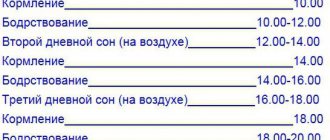Every young mother should familiarize herself with the baby’s menu at 7 months. The baby gradually grows up, becomes much more active and spends a large amount of energy. And even with proper breastfeeding, the mother may simply not have enough milk to replenish the baby’s necessary energy supply. That is why the child’s diet should be increased and foods that are high in calories and filled with substances beneficial to the baby’s body should be included.
It should be remembered that a child’s diet at 7 months when using natural feeding starts a little later than when using artificial feeding with special formulas.
What is the best way to feed a baby who receives mother's milk?
Of course, the nutrition of a 7-month-old baby should be based on the healthy and very tasty milk of his beloved mother. After all, it is with it that the baby receives a sufficient amount of substances that tend to speed up the process of the digestive system of a fragile and dynamically developing organism.
The child’s stomach is just beginning to gradually master a new “role” for him, and sometimes it is very difficult for him to digest the food offered by his mother. But certain substances present in mother’s milk help it fulfill such important “responsibilities.”
The most acceptable menu for a baby who is already 7 months old can contain a variety of dishes filled with vitamins: vegetable puree, buckwheat porridge, sweet cookies, homemade cottage cheese, fresh vegetables and fruits, fruit puree, various juices and nutritious meat puree.
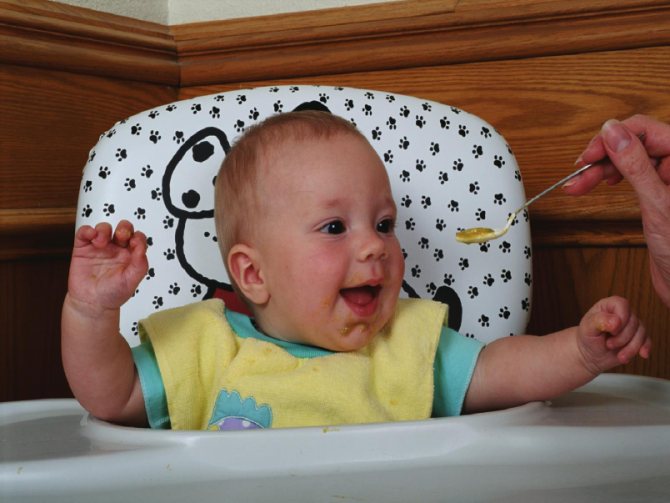
As mentioned earlier, the diet of a 7-month-old baby includes not too fatty cottage cheese. However, you need to remember that this product is very difficult for the baby’s stomach. That is why it is introduced into the diet of a seven-month-old baby in very small doses. You can give your baby 1 teaspoon of cottage cheese. An older child eats approximately 30 grams of this product per day.
A suitable and correctly composed menu for a 7-month-old baby must include fruit and vegetable purees. However, now they can be given to the baby raw. The development of a baby at this age involves the eruption of his first teeth, so he should eat only homogeneous foods. When offering raw fruits and vegetables to the child, the mother must grind them using a grater or meat grinder.
If a child at 7 months refuses to eat “raw” puree, then you need to try it, as it may be sour and should be mixed with sweet fruit. For example, purees consisting of banana, carrots and apple will turn out very tasty. However, you cannot add sugar or other sweeteners to such a dish.
You can feed your baby 7 months with cookies. However, women are very often afraid that their child will bite off a large piece. To avoid this, you can soak the cookies in tea or milk.
In the morning, you can offer your baby breast milk and after a while porridge. For lunch he can eat chicken soup, vegetable puree and meat. The afternoon snack most often consists of breast milk and juice. For dinner, give your child cottage cheese and some porridge.
Authorized Products
A child aged 7 to 11 months, regardless of whether he is breastfed or bottle-fed, is allowed to include in the diet:
- Porridge from cereals: buckwheat, semolina, rice, corn, also oatmeal;
- Fresh fruit (apple, banana). Citrus fruits are excluded;
- Fresh vegetable light soups made from vegetables, green soups made from parsley, dill, broccoli are especially useful;
- Vegetables that are present in soups can be pureed by grinding until smooth, without adding spices or salt;
- Dairy and fermented milk products promote good digestion. Low-fat cottage cheese is especially good for children;
- To maintain a sufficient amount of phosphorus, B12, A and selenium in the body, you can add rationed chicken egg yolks;
- Natural butter contains proteins, as well as vitamins A, B, C, D, E;
- Boiled lean beef or veal, minced;
- You can give baby cookies or homemade crackers (note that many companies add sugar or palm oil to such products).
Feeding does not mean giving up breastfeeding; you can continue to give adapted formulas. There is a special table that adapts to the baby’s diet. A variety of purees, which are sold in pharmacies and have all the quality guarantees, can also be included in the diet.
How to feed a baby who is bottle-fed?
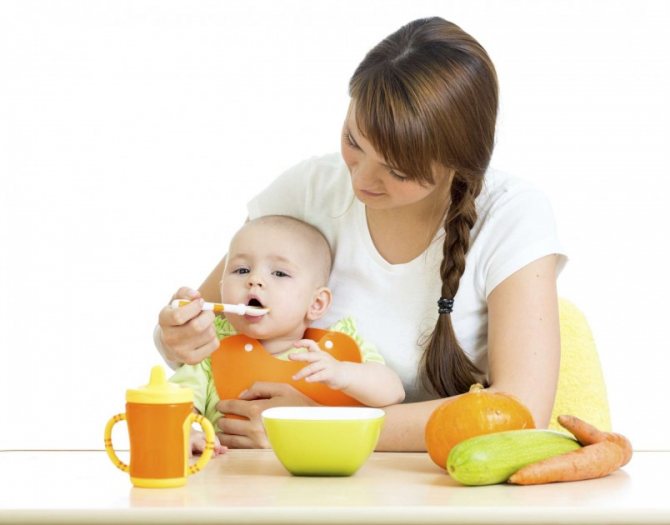
A formula-fed baby needs a properly selected diet that contains the required amount of carbohydrates and proteins.
Therefore, you can give your baby nutritious meat purees. In the morning, you should offer your beloved child formula milk. After a few hours, you can give him porridge and some fruit puree.
The lunch menu may consist of pureed meat, chicken soup, juice and cookies. The afternoon snack most often consists of milk mixture, cottage cheese and cookies. For dinner, please your baby with fruit and meat puree. You can also give your child porridge to which a small amount of butter is added.
What is the time to introduce?
The classic scheme for introducing complementary foods to a child on formula includes a certain order of inclusion of foods in the diet. Vegetables are introduced first, then porridge, egg yolk, butter and cottage cheese (the baby should already consume all this by 7 months), then meat and bread, and closer to 8 months the baby can be offered kefir.
According to this scheme, the menu for a 7-month-old bottle-fed baby
You can add meat puree in a small amount and add another quarter of chicken yolk (now he can eat half a yolk). If mom is a little late in introducing the yolk, then it’s time to let her baby try it. If your child is prone to allergies, you can start introducing him to this food with quail egg yolks. Egg whites should not be given under any circumstances. Butter must be in. It should have been introduced earlier, but if for some reason it didn’t work out, at this age it’s time to try again.
At the age of 7 months, you can offer your baby a piece of bread. You can give no more than 5 grams. It is better to offer a crust of slightly dried bread. If the mother did not give her child dairy-free cereal porridges, then at this age he should already eat these dishes, and milk porridges are also allowed. It is better to purchase specialized cereals for baby food or add an adapted milk formula to the dish.
Under no circumstances should you feed a baby cow's milk; even hypoallergenic goat's milk is not recommended by pediatricians for 7-month-old babies. According to some reports, at this age a baby is allowed small pieces of hard cheese (5-10 grams if the mother did not introduce it at 6 months and 10-30 grams if she has already introduced cheeses to the child’s menu). But this product is very allergenic and finding good hard cheese is now problematic, so you don’t have to rush with this product.
What menu can be used to feed a baby who is on mixed feeding?
Many mothers want to know what a baby who is still fed breast milk and special formulas should eat. After all, sometimes the production of a sufficient amount of healthy mother’s milk occurs in very small doses and the child simply does not have enough of it. Therefore, good milk formulas have long been created for such children.
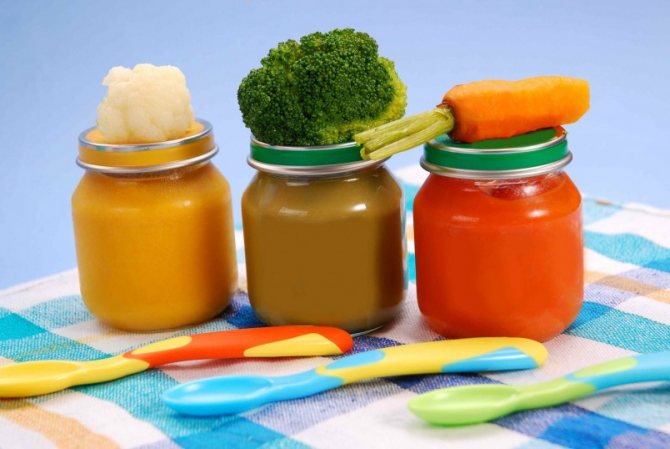
Feeding the baby in this case may include: various cereals, meat, fresh juices, fish, cookies, homemade cottage cheese, vegetable and fruit purees. Thus, the diet of a 7-month-old baby is practically no different from the diet of a breastfed baby. In this case, a table that has long been used by many mothers will help you choose products, which explains in detail the number of servings needed for the baby. There is only one difference: the child needs to be fed with fermented milk formulas, which normalize the functioning of the digestive system.
What can you feed a baby at 7 months?

Now we have come to the most important question. At the age of seven months, absolutely all children have a varied menu. However, it still differs in its composition.
Naturally nourished baby
At the age of seven months, porridge (but only representatives of the gluten-free range), fruit purees, compotes and juices are added to the baby’s diet. It is already allowed to sometimes add a little butter (butter) to the prepared dish. But you should still avoid salt and sugar.
Now you can introduce new types of vegetables, buckwheat, rice porridge, fruits. The main thing to remember is that the baby still needs food of a liquid and uniform consistency. We are still introducing new products a little at a time and monitoring how the child’s body reacts.
As for juices and compotes, prepare or buy them based on products to which the child’s body has already adapted. And it is important to know that juice prepared at home must be diluted by half with special baby water.
I first introduced apples and pears to my toddler at this age. And the first drinks I gave were clarified apple and pear juices. The first of the porridges was buckwheat, cooked in water (it was still too early to cook with milk). The baby liked the new products and, fortunately, was accepted normally by the body.
Baby with artificial feeding
The artificial baby's menu is already quite varied. It includes many products. Vegetable purees, cereals and fruit purees remain irreplaceable. If you haven't yet introduced egg yolk, fish and meat, now is the time. It is important to remember that the portion of food for such children should be one and a half times larger than for those who are breastfed. The food intake can be calculated as an eighth of your child’s body weight.
What should you do if your seven-month-old baby has allergies?
Sometimes women have a question about what to feed a 7-month-old child who is allergic. In this case, you need to remember that you should exclude from the diet the product that caused the allergy. Most likely, the baby’s gradually developing body is simply not ready to accept new food.
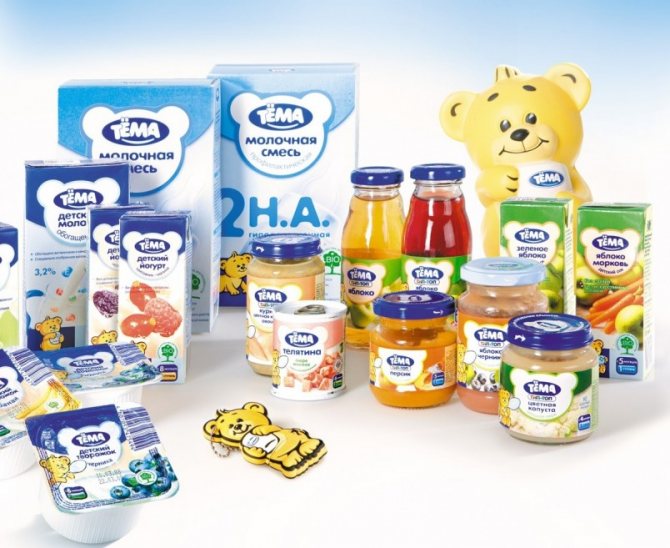
You can introduce this product into your child’s diet after about 2 to 3 months. And it is best to give the baby a small amount of the product that previously caused the allergy.
At seven months, the baby’s body’s reaction can be completely unpredictable. Therefore, it is best to contact a qualified pediatrician who will give appropriate recommendations.
Rules for feeding a 7-month-old baby
Despite the fact that the artificial baby began to eat adult food earlier than the child, whom the mother continues to breastfeed, his enzymatic system matures faster; there is no need to rush to introduce new dishes, as well as to increase the amount of foods in his diet at an excessive pace. The digestive system matures in children at different times, and if the baby refuses a certain product, it is worth postponing its introduction to a later date. The mother of a 7-month-old baby is concerned about several questions. Firstly, what to feed the baby, and secondly, how much complementary food should be given to him and how to feed your child correctly.
At the age of 7 months children
They are already sitting confidently, are actively interested in surrounding objects and are learning, including how to use cutlery. Therefore, when feeding your baby you should:
- seat him at the table with adults, although for now in his personal children's chair;
- one of the dishes is served in the form of finely chopped pieces that the child can eat with his hands;
- when feeding porridge, you need to give the baby a baby spoon and give him the opportunity to learn to eat on his own (of course, he will splash some of the food, knock on the plate of porridge and smear not only his face, but you need to come to terms with this, since the time to learn has already come);
- It is better to offer drinks to the baby in a cup (you can use a sippy cup or sippy cup).
The rules for introducing new products to the baby’s menu remain the same as at an earlier age. You need to start with minimal amounts of food (up to 5 grams), increase the amount gradually, and do not introduce “new things” when the child is sick, capricious, or has been vaccinated.
At the age of 7 months, the child still eats 5 times a day, but it’s time to prepare him for “adult” 3 meals a day
The main distinguishing feature of the development of eating habits in a child of this age is the formation of a daily routine close to that of an adult.
This means that three meals will be main (breakfast, lunch and dinner), complete in terms of food volume, and two meals (first breakfast and afternoon snack) should be a light snack. Therefore, it is worth forming a healthy habit for your child to eat porridge in the morning (you can have milk), soup with meat for lunch, and cottage cheese or apples during the afternoon snack. This useful habit will remain with the baby when he grows up and the number of meals is reduced to 3 times.
At this age, it’s time to move from homogeneous purees to more formalized foods.
You can partially grate it on a special grater, leaving a small amount finely chopped or grated onto a larger grater. Vegetables should no longer be chopped in a mixer; they can be crushed with a regular fork.
The recommended average norms, for example, 180 grams of porridge per day, are, of course, quite informative, but if a child does not want to eat the specified amount of vegetables or porridge, or, on the contrary, he is hungry, what should parents do? Averages are just recommended amounts of food. How much each individual baby needs depends on its constitution, activity and metabolism.
Today, the most popular method for calculating food requirements is called volumetric. A child aged 7 months should receive an amount of food equal to an eighth of his body weight. By this age, girls weigh on average about 7.6 kg, boys - 8.3 kg. The calculated value can be taken as 8 kg, the eighth part correspondingly is 1 kg of food, taking into account the milk formula that he drinks per day. Milk accounts for slightly less than half of this volume. A seven month old baby must:
- drink 180-200 grams of milk in the morning and 180-210 grams before bed;
- eat 180-200 grams of vegetables per day;
- 150-180 grams of porridge per day;
- the rest of the volume is filled with fruit (up to 70 grams), meat puree (up to 30 grams), egg yolk (necessarily hard-boiled), cottage cheese (up to 50 grams), juice, bread or children's cookies and butter.
Proper introduction of complementary foods not only stimulates the child’s digestive system, it also performs a developmental function.
When a child picks up small cubes of vegetables and fruits with his fingers, he trains fine motor skills by looking at colored pieces of food, learns to recognize colors by tasting foods, trains his taste buds, and learns eating habits.
